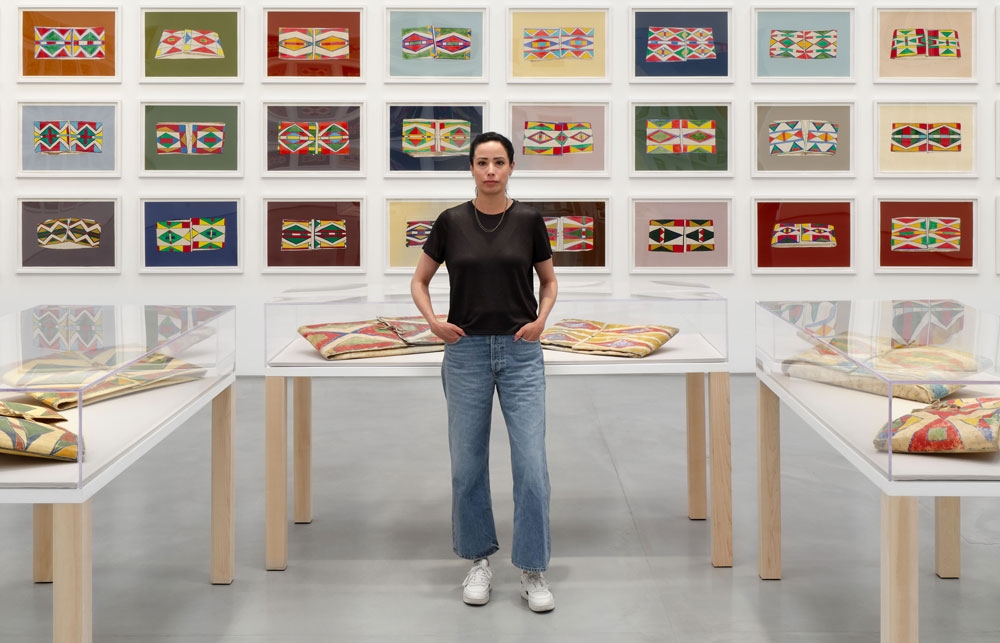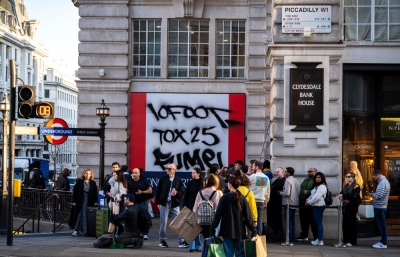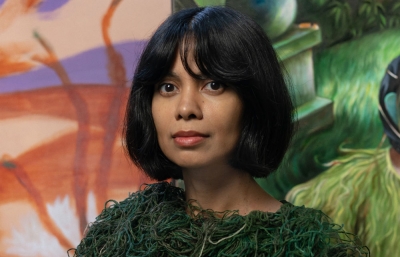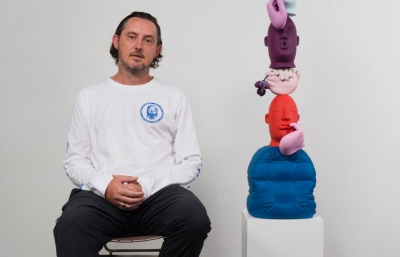Wendy Red Star
What's In a Name
Interview by Shaquille Heath // Portrait by Paul Salveson at Roberts Projects
“A rose by any other name would smell as sweet.” During my conversation with Wendy Red Star, I kept thinking about Shakespeare not only because of the alluring way in which Red Star talks about her work as inherently possessing a divine sense of poetry in itself, but specifically because of that famous verse, which references the fact that names do not inherently change who or what we are. But even the most famous poets make mistakes—and this might be one of his.
As someone whose name elicits discussion in every introduction I have, I would argue that this singular word has shaped my identity. In Red Star’s Summer 2024 exhibition at Roberts Projects, Bíikkua (The Hide Scraper), she pleads this same case. A part of her extensive practice is the skill of excavation, sorting through archives and uncovering truths painfully locked away long ago. Within this new body of work, each piece is inspired by real bishkisché, rawhide cases fabricated and decorated by the women of indigenous tribes throughout North America. These works are individually named in honor of an Apsáalooke woman ancestor from her tribe, pulled directly from the U.S. census, where birth names were stripped away by the American government, as exemplified by Red Star’s own great-great-grandmother in Her Dreams Are True. The convention of naming seems the perfect place for poetry to flow, and of course, it is the women whose matrilineal traditions are given no regard. Restoring their name bestows honor to their identities and all of the art history that was created within.
Red Star spoke with me about the power of this project, specifically its positive impact in helping her find her place in both the art world and the art canon, even after decades of making work. It’s beautiful to watch someone find purpose and meaning, and it’s beautiful to look back upon Red Star’s work and legacy to see all the roads that brought her to this moment. In searching for the names of others, she made a sacred discovery of her own.

Shaquille Heath: I read in a previous interview that you don't often think of yourself as an “artist.” I thought that was really cool! Can you tell me more about that?
Wendy Red Star: Yeah, from early on. But I feel like with age, maturity, and perspective, I had always felt like I didn't quite fit in, especially in my arts education. It happened both in undergrad and graduate school, and then professionally. In grad school, it used to be pretty torturous because the message I felt I was receiving was that if I wanted to have success within my art career, I would have to change a lot of my aesthetic values and make great compromises. I'm big on integrity and authenticity, and I thought that would actually kill me if I had to go with what didn’t feel right, especially in creative endeavors.
Now I'm 43, and the way my practice has unfolded, as well as the research that I do to understand the history of my community and the US government, I’ve come to realize that there's a big, powerful aesthetic vocabulary that my community already possesses. That’s what I've been trying to work with this whole time, and I feel the show coming up at Robert's Projects called Bíikkua (The Hide Scraper) has been sort of a revelation for me. I used to think I could never be a painter, and then I thought, “Wait a minute, maybe it's because I was never shown.” I guess you could say, quote, unquote, that the “art history” of Apsáalooke and plateau women's painting, you know, has not been thought of as art but as designs that represent the landscape in the entire community. They're meant to be seen while they're traveling as a calling card for other communities to know what tribe you're from. That, to me, was really powerful. I think it's hard for me to step out of this sort of Western way of thinking about art to understand this. Because no one's grown up outside of a colonial lifestyle for a long time. So much of what I felt was that I was doing things wrong and needed to change. And so, by studying centuries of these paintings, I realize that this is where I was supposed to be this whole time. I finally feel like I have a place. So I don't need to fit into the art world. I'm really happy to be supported! But I'm going to continue down this path and create what I’m calling an archive of “new” art history that I think lots of people could relate to, especially if they have that same kind of outsider feeling that I did.


What a beautiful and really profound investigation and exploration you've just experienced. And hearing this, knowing how long you've been making art, how great that you can still make these huge artistic discoveries at various points in your practice.
Yes, I think being an artist is a gift, because how often does that happen to an individual in whatever field that they're working in? What I've loved so much about being an artist, which was never conveyed to me at school, is that it could ever go down the way that I've been working. I'm just learning every time I make art, and I am very curious. I love to learn. I love to ask questions, and I realized that making art for me is actually learning. And what I learn, I get to share. Hopefully it is open enough for people to get something out of it, as well. But it truly is an incredible career. It's not without its own problems, but it's been a really wonderful path to take.
Tell me more about your exhibition at Roberts Projects this past summer.
I was making studies of these historical suitcases that came from a project I did a few years ago with the Public Art Fund, which has an initiative where they invite artists to make artwork for bus shelters. At first, it was New York City and the five boroughs. Then they opened it up to Boston and Chicago, and they wanted me to have something that sort of anchored each city within the artwork. So what a task, ya know?! Haha!
I thought, well, here's an opportunity where I have the Public Art Fund to aid me. I wanted to gain access to some of the cultural institutions in all of those cities that have Apsáalooke material. So I said, Let's do that, and then, depending on what they have, I will make a project. It's sort of like bringing something that is of me and my community, that is away from the community, in a city that people probably don't even know about. Once I started looking across all the different collections, I realized that they all have bishkisché, which is the Apsáalooke word for parfleche cases or rawhide cases and translates to “dog pack.” That in itself gives you an idea of how old these cases are. Crows didn't get horses until the 1700s.


Oh, wow! Hundreds and hundreds of years.
Dogs used to carry everything before the time of horses—to give you an idea that it's definitely before contact. Digging into these cases, they're utilitarian. For the longest time, I've seen them and thought, they're cool… and then I would look at some beadwork or something shiny, haha! But I didn't realize that they're actually the foundation for the aesthetic design of the community. Each tribe has its own distinct colors and patterns. They are these visual cues to each other, where we can tell their origin and who we trade things with. They're meant to travel. They’re meant to trade. And they'll work perfectly for these bus shelters as traveling cases. So for that piece, I made these big posters utilizing bishkisché that were in each of those institutions, and then I’d just write things in the background as I was learning about these cases through research. Once I finished, I was like, This is not over; I need to continue because nobody currently makes bishkisché on my reservation. Sometimes people make miniature sized ones, but nobody is doing that practice whatsoever. That is a woman's art form that has been lost.
I wanted to make an archive of studies to have that and for it to be accessible to Apsáalooke people. It was really wonderful to have the opportunity to have a one-on-one experience with the maker. I'm trying to follow them as closely as possible—their colors, their line work—so I get to know them within the process, or at least the way in which they are making these designs. I really love that, because unfortunately, in most of these cases that are in collections, even private ones, there are no names attributed to them. That wasn't important to have, and I think the women were also not thinking of these as art objects, you know. So I just decided I needed to continue, and I have found over 500 so far. And this is just from digital research, from going to different auction houses or museum collections. And then, of course, now that I'm more privy to it anytime that I'm going around, if I see some, then I will photograph them. I'm just going to try to archive as many as possible by making painted studies.
And then the other thing that I thought was really important is that this is very much centered on women's work and the women being erased from that work, so I wanted to honor the name of a female for each of these pieces, even if they didn't actually make that work. I'm sure they were bishkisché makers or someone in their family was, so I started looking at the 1885 census records for my tribe and picked out over 1000 female names. Every time I make one, I write their name down, or their translated name in English. Another component is that when they started to divide the Crow Reservation up into individual allotments, they would divide them to heads of household. And so my last name, Red Star, is actually my great grandfather's name. Every Crow just had an individual, unique name, no one had last names. And so when the white folks and the government were turning the reservation into plots and allotments, they did it in the same way that they do it, which is a very patriarchal system. So with the head of household usually being a man, anybody in his house was given a Christian first name and then used the head of household’s name as a last name. So that in itself is really interesting, growing up on the reservation, going to school with, like, George Good Luck. But that’s actually a person. Each of us carries a person with us, but they're all men. My great great grandma, her name was Her Dreams Are True. That's the most amazing name! But all those names have not been carried through, like some of the male names. And for instance, her English name is Julia, and her dad was around during the allotment era, and his name's Bad Boy. So her name is Julia Bad Boy.
Her actual name was literally and completely wiped away.
Yeah, yeah. Everybody. Except that the men got to keep their name, but then they got a Christian name in front of it. I want to have an archive of the women's names. They're almost like poetry to me. There's a name that I can't get over, “All She Has is Yellow.” You know, I love these names! And the names actually tell you so much about what was important to the community, what was honorable.
I'm so excited! People are going to walk in, and it's just going to be color filled. A choir of native women's paintings. And that's what I want, selfishly, hah! I want to walk in a space where I can just study all of these cases. They're all on these beautiful earth tone, pigmented backgrounds. They'll be shown in grids on each wall, and you'll have the opportunity to really take your time. Or be totally overwhelmed, because it's incredible. I have no doubt that I'm going to be able to find 1,000 bishkisché. No doubt. And it’s just going to be kind of a lifetime project for myself. The other thing people will see is that I have now started collecting them. I had this dream of going back to my reservation during this cultural event we have called Crow Fair, which happens every August, and having a parade car with my daughter. She's 17. Having her on top in her outfit, but then having the car just decked out in all the bishkisché! Haha! I saw an image in the ’60s of this Yakama woman who came to our reservation, and she had six. I was like, That's the dopest thing I've seen, ever! And I've never seen anybody do that. I want to be like the bishkisché queen of the parade. So I've been collecting those I'll be showing. I do think it's nice for people to have a reference point, so they'll be able to see some of these historical ones and kind of get an idea.

The Last Thanks, 2006, Archival pigment print, 24 x 36 inches, Edition of 15
When you say people feel overwhelmed in their reaction, I feel like that's going to be very true, as I imagine being surrounded by all of those works. And going back to the naming, which I feel is one of the most powerful parts of the work, it had me wondering if that was a simple action for you to do: creating the piece and selecting the name. Or was it a more meditative practice?
That's a good question. They actually just kind of come together pretty seamlessly. I've created a big list, and then I’ll have work, and I'll just look at my list and think, “Oh yeah, this is this one.” So it's not a struggle at all. It just kind of speaks. I want to be this one, you know.
They call out to you. They're like, I'm here. I'm ready!
Yeah! And I think it's really fascinating the way in which institutions set up collections of native objects. I think subconsciously, the viewer walks in thinking about men. Especially in the Plain’s section. I think they think about chiefs and warriors. But a lot of the things that are on display are all woman-made. But you're not thinking about native women when you walk in there or walk out, right? So that's another thing that, for some reason, the institutions have always erased native women and their contributions to their very own collection. It's so wrong. It's also really weird, because it always kind of catches me off. But we’re set up to think about men a lot of the time.
Absolutely. I would love to talk more about research and your own collection practices. With the bishkisché, how many have you been able to find in person and bring into your physical possession?
Some can be like five grand—anywhere from 500 to five grand, haha! I'm not wealthy, so I'm slowly amassing a collection. But that's the crazy thing; they’ve also been around. Ever since I started looking into museum collections. In my community, we were prolific in making bishkisché. A lot of the Plateau communities, as well. So I feel like I can safely say that nine times out of ten, you will find a rawhide case in a collection. I've run into probably 100 just from looking at research on my own and seeking out cases. It's kind of fun where it's almost like such an obscure thing, but once you're dialed into it, you know kind of where to go. I’ve found them in pawn shops. On eBay. I’ve found them in remote cities in Idaho, hah! I do have this guy that I really like. I see him every time I go to Montana. He has a pawn shop called Yellowstone Pawn. He's also a bail bondsman. So when you walk in, it's really hardcore and freaky, because he's got mugshots of everybody that he’s helped out.
Iconic!
Haha! He's such a nerd; he grew up on the Cheyenne reservation. But he also collects things, and so we just go into his office and have very nerdy conversations. We're like little kids; we’re so giddy. But since he knows that I'm into collecting those, I'll get like a random text, “Into this?” I’m like, Yeah! So it's kind of turned into that, which is also kind of a weird, magical world in itself. Not only in the research, but the hunting for them, as well.


I'm very of the, “the universe works in mysterious ways” kind of person, and I wonder if a lot of these pieces find you? Because they know that you’re seeking?
I feel that way very much. I actually feel that way in some of the other art that I've looked into. I have an exhibition in 2026 at the National Portrait Gallery, and it's going to be on the Crow tribe's last chief. His name was Chief Plenty Coups, and so I'm doing a show dedicated to him because he traveled to Washington, DC, over 11 times. I’m working with two curators, and I've done two research trips, and every time I go, I find him everywhere. We’ve had these incredible experiences. He's in the herbarium that houses all the plants. He's at Arlington Cemetery; he's got a big section in there. I'm like, wow! So we just keep finding him, and it's just a little bit too uncanny. But I feel it feels really good, because I'm like, Oh, he wants this exhibition. He's just throwing stuff at us. So we're actually going to be traveling to Montana, going to his state, visiting my dad, going to the Little Big Horn College on the Crow reservation, and finding more research. So we'll probably find some more wacky things about him. He's definitely a character.
But I often have that feeling. I had a really magical experience at the National Museum of the American Indian. I did a Smithsonian Artist Research Fellowship, and my ancestors just kept coming out in the research. I was able to hold my great grandfather's necklaces that were in the collection. And then, through reading the notes on him, he sold some of his grandfather's stuff, like eight medicine bundles, and his grandfather’s name was Green Skin. I never heard of him. So I call up my dad, “Do you know Green Skin?” He’s like, “That’s Bear Tail’s grandpa!” So that's like my fourth great ancestor there. And then, of course, I found Her Dreams Are True, Julia Bad Boy, a photo of her. It’s really wild to me how they just seem to want to say hi and let me know about everything there. It happens quite a bit. And it’s another reason why I feel so compelled to continue to do the work.

I believe in all of that stuff very much, so I love hearing examples like that. I think that's so beautiful. So much of your art pulls from traditions, cultures, and findings that I was wondering if there has ever been a concept that you've thought: This is too exhausting to explain to the white people?
All the time. Not just to white people, but also with my community as well. That's trauma, you know? There's a lot of trauma. I'm really into perseverance, and that's what's so inspiring about my community and a lot of native tribes. But on the opposite side of that is deep, deep trauma. So a lot of times, especially if it's people from my community that are maybe upset with something that I did, I automatically know that it's the trauma that's speaking to me. That can be really hard because everything that I read on Crow folks comes with a side of trauma. Even if there’s a victorious thing, it comes with a lot of trauma. So the work that I do is really emotionally hard for me. Some of these things are just really sad. I think that can be really taxing when talking to white folks, because they don't have that sort of understanding, I guess in general, about the emotional work that goes into my practice. They just get the final piece. But that emotional work is actually really rewarding. And I think the two curators that I’m working with in DC are getting to have a very inside look at that. And share in those sorts of experiences that I get when I'm unearthing things.
Wendy Red Star’s solo exhibition, Bíikkua (The Hide Scraper), was on view this past summer at Roberts Projects. Her exhibition at the National Portrait Gallery will open in 2026.
This interview was originally published in our FALL 2024 Print Quarterly edition.
This interview was originally published in our FALL 2024 Print Quarterly edition.






